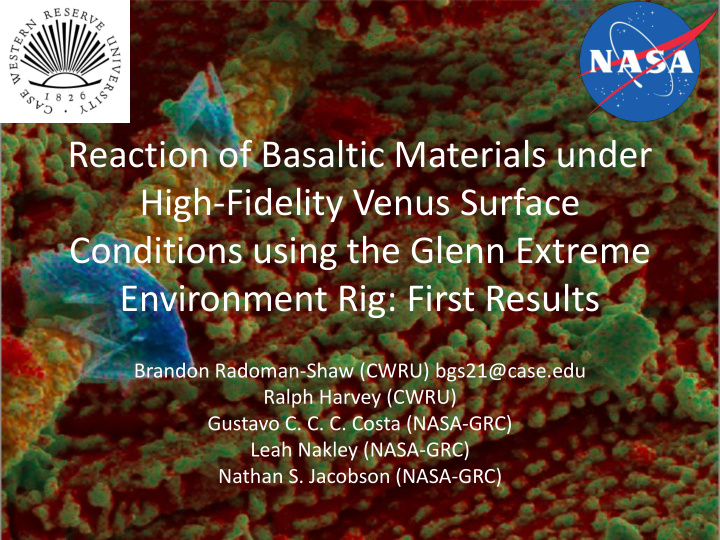



Reaction of Basaltic Materials under High-Fidelity Venus Surface Conditions using the Glenn Extreme Environment Rig: First Results Brandon Radoman-Shaw (CWRU) bgs21@case.edu Ralph Harvey (CWRU) Gustavo C. C. C. Costa (NASA-GRC) Leah Nakley (NASA-GRC) Nathan S. Jacobson (NASA-GRC)
Experimental Design Reactions?
Design
Final Sample List Diopside Oligoclase Leucite Venera 13 Siderite Rhyolite Venera 14 Magnetite Pyrite Mafic Vega 2 Quartz Pyrrhotite Nepheline DNC-1a Dolerite Olivine Hematite Syenite AGV-2G Andesite Enstatite Wollastonite Phonolite BHVO-2G Labradorite Calcite Trachyte Basaltic Goethite Andesite NKT-1G Quartz Basalt Nephelinite Tholeiitic BCR-2G Basaltic Flood Basalt Kamoamoa Olivine Basalt Halemaumau spatter Pu’u O’o Lava Flow
Venus Mixture After Bullock and Grinspoon (2012)
Exposure
SO 2 SO2 350 300 250 Concentration (ppm) 200 SO2 150 100 50 0 11/12/15 11/22/15 12/2/15 12/12/15 12/22/15 1/1/16 1/11/16 Day Marcq et al. (2013)
Sample Trays
Samples
Samples
Calcite
Calcite Calcite
Calcite
Calcite CaSO 4 + CO (g) = CaCO 3 + SO 2(g) Anhydrite + CO = calcite + SO 2
Conclusions • Initial electron microscopy at low resolution suggested major particulate deposition. – Effect of particulate deposition is unknown – Future electron microscopy suggests evidence of reaction. • Necessity for sub-chamber for higher fidelity atmospheric control and reduction of chamber particulate deposition. • Longer duration of experimentation, beyond the 42 day longest exposure.
Recommend
More recommend